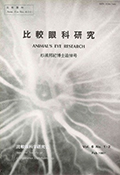Volume 6, Issue 1-2
Displaying 1-8 of 8 articles from this issue
- |<
- <
- 1
- >
- >|
Review
-
1987 Volume 6 Issue 1-2 Pages 1-13
Published: 1987
Released on J-STAGE: December 25, 2020
Download PDF (3657K)
Reports and Lecture at 6th Symposium on Some Problems in the Field of Comparative Ophthalmology
Special Lecture
-
1987 Volume 6 Issue 1-2 Pages 15-21
Published: 1987
Released on J-STAGE: December 25, 2020
Download PDF (2492K)
Reports
-
1987 Volume 6 Issue 1-2 Pages 23-33
Published: 1987
Released on J-STAGE: December 25, 2020
Download PDF (2686K) -
1987 Volume 6 Issue 1-2 Pages 35-41
Published: 1987
Released on J-STAGE: December 25, 2020
Download PDF (1431K) -
1987 Volume 6 Issue 1-2 Pages 43-51
Published: 1987
Released on J-STAGE: December 25, 2020
Download PDF (2136K) -
1987 Volume 6 Issue 1-2 Pages 53-61
Published: 1987
Released on J-STAGE: December 25, 2020
Download PDF (2615K) -
1987 Volume 6 Issue 1-2 Pages 63-68
Published: 1987
Released on J-STAGE: December 25, 2020
Download PDF (1491K)
Brief Note
-
1987 Volume 6 Issue 1-2 Pages 69-72
Published: 1987
Released on J-STAGE: December 25, 2020
Download PDF (1120K)
- |<
- <
- 1
- >
- >|
